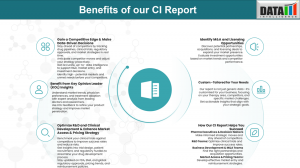Hunter Syndrome Therapeutics Evolve: Novel CNS-Targeting Therapies Set to Challenge Elaprase’s Market Monopoly
New CNS-penetrant therapies and gene therapies are poised to transform the Hunter Syndrome landscape, ending Elaprase’s long-standing treatment dominance.
Hunter Syndrome care is at a pivotal moment. Breakthroughs in CNS-targeted therapies and gene therapy are rewriting expectations for outcomes and redefining what’s possible for patients and families.”
AUSTIN, TX, UNITED STATES, June 15, 2025 /EINPresswire.com/ -- Hunter Syndrome (Mucopolysaccharidosis Type II, MPS II) has long presented a therapeutic challenge in rare disease care, primarily due to its neurological complexity and progressive, multi-systemic burden. Caused by a deficiency in the enzyme iduronate-2-sulfatase (I2S), MPS II results in the toxic accumulation of glycosaminoglycans (GAGs) across tissues—ultimately impacting somatic and cognitive functions. Though Elaprase, Takeda’s enzyme replacement therapy (ERT), has been the standard of care since its FDA approval, the lack of neurological benefit and high treatment burden have underscored a desperate need for innovation. Today, with multiple next-generation therapies in late-stage development, the treatment paradigm for Hunter Syndrome is on the brink of a historic transformation.— DataM Intelligence
Download CI Sample Report: https://www.datamintelligence.com/strategic-insights/sample/hunter-syndrome-mucopolysaccharidosis-type-ii-mps-ii
Epidemiological Snapshot: Rare, Male-Predominant, and Underdiagnosed
Hunter Syndrome affects an estimated 0.38 to 1.09 per 100,000 live male births, given its X-linked inheritance pattern. Despite its rarity, the burden on affected individuals and families is profound—characterized by developmental delays, skeletal deformities, organomegaly, and, in severe cases, progressive cognitive decline. Early diagnosis is critical, yet the variability in symptom onset continues to challenge timely intervention and access to specialized care.
Therapeutic Landscape: Elaprase and Beyond
Elaprase (idursulfase) has been the backbone of MPS II treatment since its introduction, offering somatic symptom relief through weekly intravenous administration. However, it fails to cross the blood-brain barrier (BBB), leaving patients with central nervous system (CNS) involvement—especially in severe phenotypes—without meaningful therapeutic options.
Outside the U.S., Shire’s Hunterase serves as a regional alternative, and Japan’s IZCARGO, approved in 2021, marks a significant milestone as the first therapy to demonstrate dual action on both somatic and CNS symptoms. Yet, the field’s true disruption is underway via late-stage clinical programs developing innovative delivery platforms, BBB-penetrant biologics, and one-time gene therapies.
Pipeline Momentum: CNS-Targeting Therapies Enter the Arena
Several therapies are under development to close the CNS treatment gap that has long defined MPS II’s unmet need.
Tividenofusp alfa, a novel fusion protein under development, is engineered to cross the BBB and act on both CNS and peripheral tissues. Its single-infusion mechanism reduces patient burden significantly compared to weekly ERT.
Verenafusp alfa follows a similar principle, combining an enzyme with a transport platform designed to facilitate CNS penetration. Though data remain limited, early trials suggest encouraging CNS biomarker responses.
On the gene therapy front, RGX-121—developed by Regenxbio—offers a transformational approach. Administered as a one-time IV infusion, it is designed to deliver long-term I2S expression in the CNS using an AAV9 vector. Regulatory filings are anticipated in late 2025, and if approved, RGX-121 could represent the first functional cure for Hunter Syndrome.
Competitive Landscape: A Market Ripe for Disruption
Takeda’s Elaprase continues to dominate the global MPS II market with annual treatment costs exceeding $500,000. However, the emergence of newer therapies is set to shift this landscape rapidly. While Elaprase maintains a strong foothold in the U.S. and Europe, therapies like IZCARGO and Tividenofusp alfa are poised to establish a new benchmark for efficacy—especially in the context of CNS involvement.
Key differentiators for upcoming therapies include:
- Mechanism of Action: CNS-targeting fusion proteins and gene therapies with long-term expression capabilities.
- Delivery Innovations: Less frequent infusions or single-administration gene therapies replacing weekly ERT regimens.
- Patient-Centric Design: Home-based treatment options, reduced infusion reactions, and fewer hospital visits.
- Economic Value: Though high upfront costs are expected, the long-term cost-effectiveness of one-time or monthly therapies compared to lifelong ERT provides a compelling payer narrative.
Target Opportunity Profile (TOP): Defining the Future Standard
To surpass Elaprase and redefine treatment for Hunter Syndrome, upcoming therapies must meet a comprehensive set of clinical, functional, and economic benchmarks. The TOP framework suggests:
- CNS Efficacy: Demonstrated improvement in neurocognitive function and long-term neurological outcomes.
- Low Immunogenicity: Reduced anti-drug antibody development and infusion reactions.
- Durability: Long-lasting therapeutic effect, ideally through gene therapy.
- Patient Experience: Fewer infusions, simplified logistics, and enhanced quality of life.
- Health Economics: Favorable cost-benefit ratios supported by reduced hospitalizations and improved functional outcomes.
Strategic Implications for Drug Developers and Investors
The Hunter Syndrome space is transitioning from legacy enzyme-based treatments to precision, CNS-focused, and curative options. Developers looking to enter or expand in this market must differentiate their assets not just on efficacy, but also on delivery platforms, regulatory readiness, and commercial scalability.
Book Your Free CI Consultation Call: https://www.datamintelligence.com/strategic-insights/ci/hunter-syndrome-mucopolysaccharidosis-type-ii-mps-ii
Key Strategic Considerations Include:
- Prioritizing CNS-accessible platforms—be it via BBB-penetrant proteins or direct gene therapy vectors.
- Building robust early-phase biomarker data to support long-term value narratives.
- Collaborating with payers early to define value-based reimbursement pathways, especially for one-time therapies.
- Expanding newborn screening and early diagnostic programs to support earlier intervention and broader market uptake.
Read Related CI Reports:
1. Friedreichs Ataxia Disease Modifying Therapies Market Intelligence
2. Cell and Gene Therapy | Competitive Intelligence
Sai Kumar
DataM Intelligence 4market Research LLP
+1 877-441-4866
email us here
Visit us on social media:
LinkedIn
X
Legal Disclaimer:
EIN Presswire provides this news content "as is" without warranty of any kind. We do not accept any responsibility or liability for the accuracy, content, images, videos, licenses, completeness, legality, or reliability of the information contained in this article. If you have any complaints or copyright issues related to this article, kindly contact the author above.

